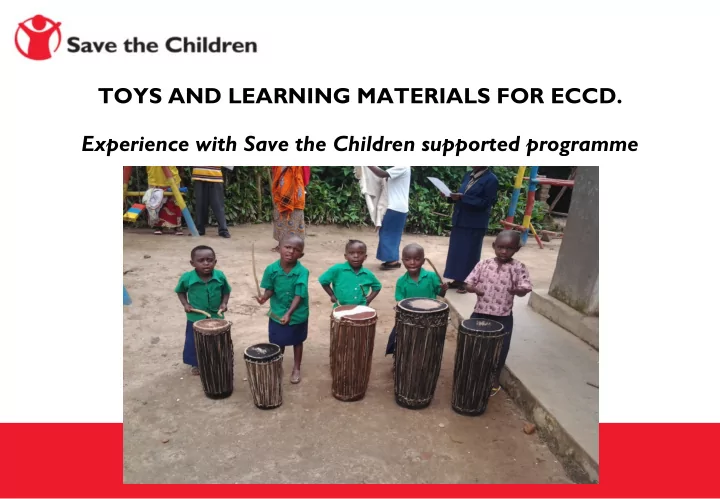

TOYS AND LEARNING MATERIALS FOR ECCD. Experience with Save the Children supported programme International Save the Children Alliance 1
How do children learn? PLAY!!!!!!!! – Play is a universal process . – Play is an optimal experience to encourage all seven identified intelligences (Theory of multiple intelligences by Howard Gardner -1983) • Vocabulary, grammar , and the ability to sustain conversational exchanges. • Music through chants, clapping games, and play with musical instruments. • Logical mathematical skills as they play with blocks, counting, comparing, and predicting as they build their constructions. • Visual spatial skills through art activities, visual matching, and making visual signs. • Bodily-kinesthetic learning through climbing, running, catching a ball, and playing a variety of sports (fine and gross motor skills). • Personal intelligence in thematic play as children become aware of their feelings, thoughts, likes and dislikes. • Social skills as children play and try out social roles, learn to see the world through other people's perspectives, and use language for negotiation and problem solving. 2 2
PLAY AND LEARN USING LOCAL MATERIALS • INDOOR PLAY AND LEARNING. – Initially Save the Children started with purchase of plastic toys from Chinese industry to equip 4 pilot centres supported since 2009 in Rubaya (Gicumbi). – Identification of local artists in Kigali and Gahini who can make a variety of toys and learning materials in wood adapted to the age of children and to the Children using wooden toys and learning materials in class. Rwandan context (abaci, building blocks, diamond shapes…): around 30 models 3
PLAY AND LEARN USING LOCAL MATERIALS • OUTDOOR PLAY AND LEARNING. – Save the Children started providing metal playground equipment in the 4 pilot ECCD centres of Rubaya in 2009 – Challenges related to metal materials: community members are unable to maintain and Metal playground equipment repair them because it requires soldering in rural areas without power supply. – Development of playground materials in locally available materials (wood, old tyres…) that communities can maintain using local skills (carpentry, construction). Children playing on the “ wooden house” 4 and developing the gross motor skills.
PLAY AND LEARN USING LOCAL MATERIALS 7 MODELS OF PLAYGROUND EQUIPMENT IN LOCAL MATERIALS 2.Set of tyres 1. Train 3. Wooden house 4. Suspended bridge 6. Swing 7. slide 5. seesaw 5
COLLECTION AND USE OF LOCALLY AVAILABLE MATERIALS WITH PARENTS INVOLVEMENT • Materials that are sometimes considered as useless can be excellent learning materials for children (bottle tops, plastic bottles, boxes, etc.) Creative activities testing with children using locally collected materials. • A toolkit for Creative Activities developed as • Training sessions with guidance for caregivers and caregivers and parents on use parents on collection and use of the Creative Activities of locally available materials. Toolkit and collection of locally available materials 6
THANK YOU! 7
Recommend
More recommend